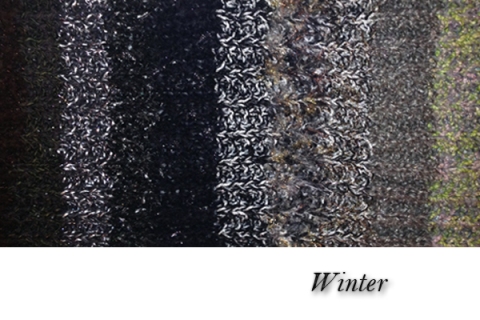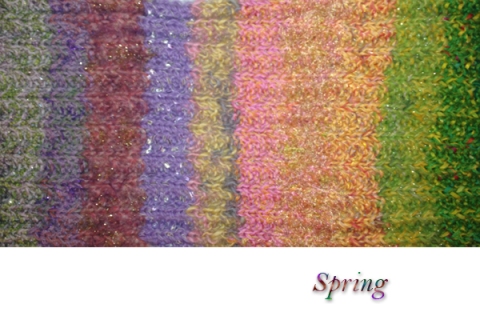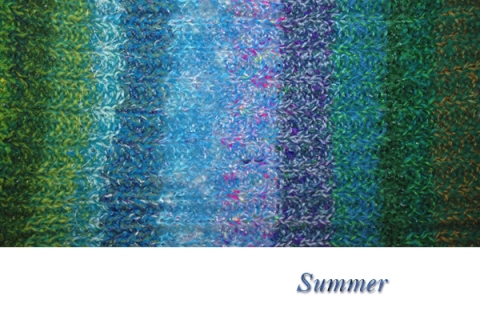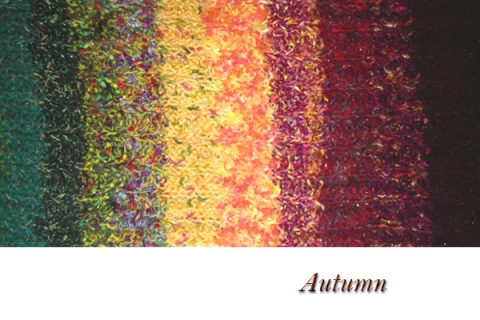You know I create color palettes. But what do I actually use them for? One of my favorite palette applications is Scraplet Skeins, the line of multi-textured yarns I create for Knittique*; each skein creates a color sequence as you knit with it. So I’m always looking for fresh color inspiration (and am constantly surprised that I never run short of ideas). I’ve thought for a long time about doing a set of four color sequences, each representing one season of the year. The problem (and the reason I kept putting off working on this): what’s fresh about that? Isn’t the whole four-seasons idea completely cliché? Could I think of a novel way to represent the seasons?
It wasn’t until I actually started playing around with the yarn colors that this concept started working for me. To begin with, I realized (about 5 minutes in) that even though I thought I knew what each season represented, I’d never specifically thought of them in terms of colors. For example, we’re all familiar with the beautiful color changes in fall foliage— but what colors are they, exactly? And unless you’re living on a tropical island, what hues do we associate with winter, which I had thought of as a lackluster period that’s devoid of color? And summer, well, I think mostly of greens, but there must be more to an entire season than greens. Even spring, associated with flowering trees and bulbs and that light leafy green that you only see in this season— how do I translate that to a specific color palette?
Then I had other issues, since I was trying to create skeins of yarn that, if used in sequence, should create a seamless transition of colors. This required a lot of planning. Winter changing to Spring, for example. I pictured Winter as bare and bleak: wet, dark brown branches turning frosty, and sparkling, starlit nights, and Spring as light, colorful, and alive— but how would I make the change without it being too abrupt? The following photos show the Winter and Spring color sequences; you can see how the end of Winter will blend into the beginning of Spring:


Once I had figured out the beginning and ending colors for each season, I really started making progress on this project; these were the critical parts, since they would determine the successful transitions between skeins. But I also felt it was important to design each color sequence to stand on its own, so once again, I focused on each individual season’s hues.
I soon realized that choosing colors to represent a season is a very subjective process. Summer in, say, Nevada, conjures up a completely different color palette than summer here in Portland, or somewhere more tropical like Florida or Hawaii. (I’ve been in Nevada in the summer; the colors tend towards sage-green and sand-gold, beautiful in its own subtle way.) I decided it wasn’t feasible, in the course of one 120-yard skein, to represent more than one color concept, so I went with what I think of as summer colors: many shades of greens, with the brilliant blues and aquas of the sea and sky, gradually darkening as Autumn approaches. Here’s my Summer sequence:

Finally, I collected the colors for the Autumn skein. I had thought this would be the easiest, but with the size restriction of the skein (120 yards total, divided into 10 color sections), it actually was quite challenging. I knew I had to start with green to transition from the Summer colors, and end with a very dark brown (to blend into the beginning of the Winter skein); that used up 2 of the 10 color sections, leaving me only 8 parts in which to change from green to dark brown without it looking too stripey (I like gradual color changes whenever possible.) I wanted gold, orange, red, burgundy— how would I fit all that in? The only way was to combine different colors of yarn in each section to blend the colors; for example, to change from green to gold, I did two sections, one with more green than gold, and vice versa for the following section.

And now, my year in colors is complete! Mission accomplished: each skein looks beautiful on its own, but also creates a smooth and subtle shift from one Season to the next if used in sequence.

If you’d like to see the knitwear design (3 versions, each with all four seasons) that I created using this color sequence, click here.
* You can find my one-of-a-kind yarns, original knitwear patterns, samples, and more in my Knittique Etsy shop. Don’t miss the specials I’m running now (including a kit to make the piece profiled here), and new deals every week until Christmas!


What a great post! I love all colours!!
As the earth tone seems to be used in autumn; I do wear these colours in spring and winter too, here’s my post about it:
http://vivalaviv.com/2014/09/21/its-spring-get-in-touch-with-the-earth-tone-trend/
Vivienne X
LikeLike